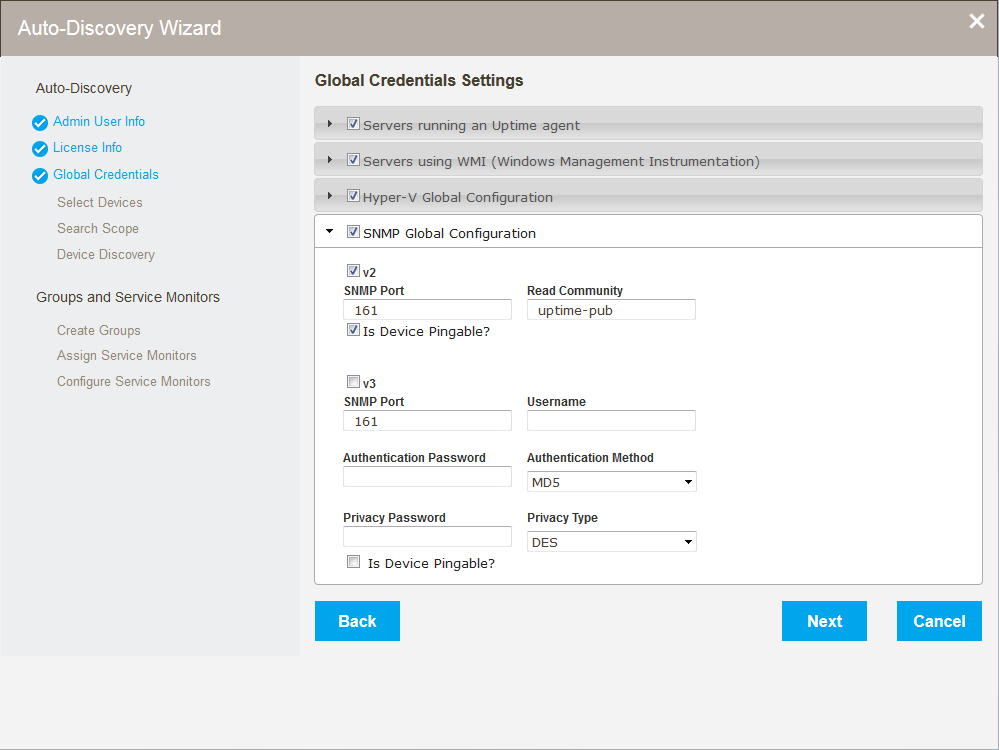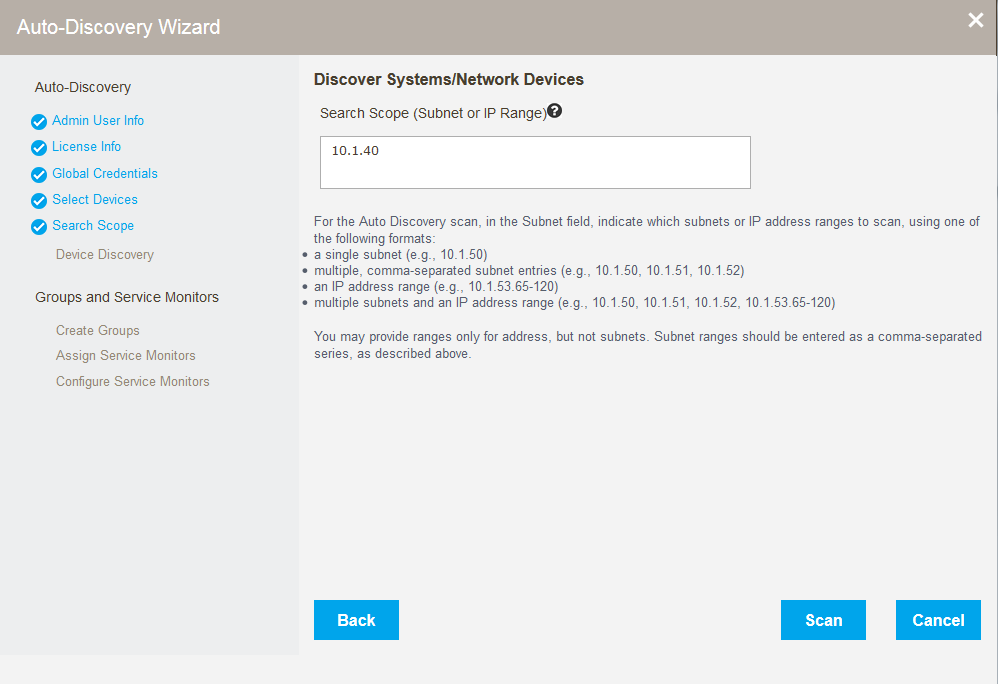The Auto-Discovery wizard runs automatically the first time you launch Uptime Infrastructure Monitor or can be launched at any time by clicking the Config tab, and then clicking Discovery Wizard from the left menu. This wizard uses the same process of discovery as the existing Auto-Discovery functionality but provides it through a wizard interface. Auto Discovery is still available in the Infrastructure tab.
Set global credentials
The Global Credentials Settings page of the Auto-Discovery Wizard allows users to set global configurations and credentials including :
- Servers running an Uptime Agent
- Servers using WMI (Windows Management Instrumentation)
- SNMP Global Configuration (v2 and v3)
Select device types for discovery
The Auto-Discovery Wizard Select Devices to Discover page lets users set options to filter the types of devices discovered when the wizard runs. All of the following device types can be discovered and added in a single pass of the Auto-Discovery Wizard:
...
Note that when you choose an option, additional configuration options appear.
Auto Discovery for Servers and Network Devices
With Auto Discovery, Uptime Infrastructure Monitor can detect systems on your network that have an IP address within a specified range, as well as other search criteria:
...
Once a list of systems in the range of IP addresses that you specified is generated, you can selectively add them to Uptime Infrastructure Monitor.
Uptime Agents
Provide Uptime Infrastructure Monitor Agent connection information to allow the Monitoring Station to detect systems that have the Agent installed on them. Select the Use Uptime Agent Global Configuration check box if this information is configured (see Configuring Global Data Collection Methods for more information); otherwise complete the following options:
- Agent Port Number
The port through which the Uptime Infrastructure Monitor Agents communicate with the Uptime Infrastructure Monitor Monitoring Station. - Use SSL (HTTPS)
Select this check box if the Agent securely communicates with the Monitoring Station using SSL.
WMI Agentless
Provide login information for an administrative Windows account if you would like Auto Discovery to scan for systems that are using WMI to collect metrics. Select the Use WMI Global Configuration check box if this information is configured (see Configuring Global Data Collection Methods); otherwise complete the following options:
...
| Info |
|---|
This option is only available on Monitoring Stations running on the Windows platform. |
Network Device
Provide connection information to allow Auto Discovery to scan for network devices. To comment to SNMP-based devices, select the Use SNMP Global Configuration check box, and then choose which version of SNMP is in use (see Global SNMP Configuration Settings); otherwise complete the configuration options as described in the next subject, "Devices using Net-SNMP."
Devices using Net-SNMP
Provide SNMP connection information to allow Auto Discovery to scan for servers with Net-SNMP. Select the Use Global SNMP Configuration check box if this information is configured (see Global SNMP Configuration Settings for more information); otherwise select the SNMP Version that your servers are using, then complete the appropriate options:
...
- Is Device Pingable? (appears only when using the Network Device option)
Check this box if you can use a ping to verify the status of this device.
Auto Discovery for VMware vCenter Inventories
A VMware vCenter server acts as a central control point for a VMware vSphere datacenter. It includes ESX hosts, VMs, as well as groupings such as clusters, datacenters, vApps, and resource pools. A VMware vCenter server's inventory, system configurations, storage profiles, and performance data can be represented in Uptime Infrastructure Monitor alongside physical systems and network devices. When a VMware vCenter is added, all of its resources are detected and can be automatically imported.
VMware
Provide VMware vCenter connection information to allow Auto Discovery to import its resources by completing the appropriate options:
- Web Services Port
Accept or modify the default port through which Uptime Infrastructure Monitor connects to the server. - Username and Password
Login credentials for the VMware vCenter administrator. - Group
The group into which newly-discovered data is placed.
IBM pSeries LPAR Server (HMC)
You can also use the Auto-Discovery Wizard to add pSeries systems that are managed by the Hardware Management Console (HMC). The HMC is an interface for managing and configuring pSeries servers that are hosting multiple logical partitions (LPARs). When an HMC is attached to one or more pSeries servers with LPARs, the servers are considered managed servers.
...
- Hostname
The name of the system on which the HMC is running. - Username and Password
The credentials required to log into the HMC.
Set the search scope
Restrict the range the Auto-Discovery Wizard searches using the Discover Systems/Network Devices page. Indicate which subnets or IP address ranges to scan, using one of the following formats:
...
| Info |
|---|
You may provide ranges only for address, but not subnets. Subnet ranges should be entered as a comma-separated series, as described above. |
Using discovered devices
Once discovered, select devices to:
- create groups
- add Service Monitors
- configure Service Monitors
Create groups
Depending on the type of devices added, Uptime Infrastructure Monitor automatically creates the following device groups:
...
The Auto-Discovery Wizard also automatically creates the following groups, which can be viewed in the Infrastructure tab:
- Applications
- SLA
Add Service Monitors
Easily add service monitors to devices found and added in discovery. Default values allow users to simply review, and then click Next on the parameter steps to add the monitors. In addition to the monitors created by default, users can easily add:
...
- Any servers added:
- MySQL Checks
- MySQL Basic Checks (runs a query to test query engine)
- MySQL Advanced Checks (pulls performance information from the DB engine)
- MySQL Checks



